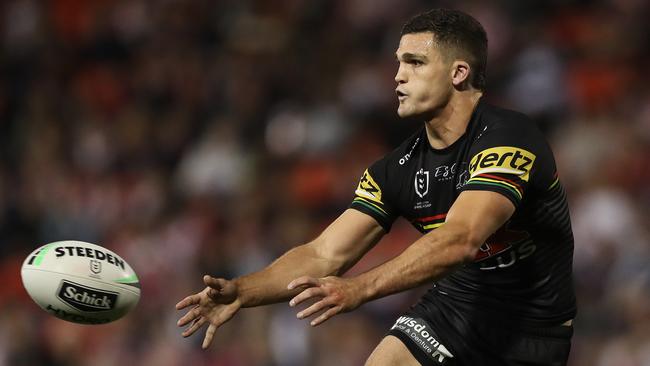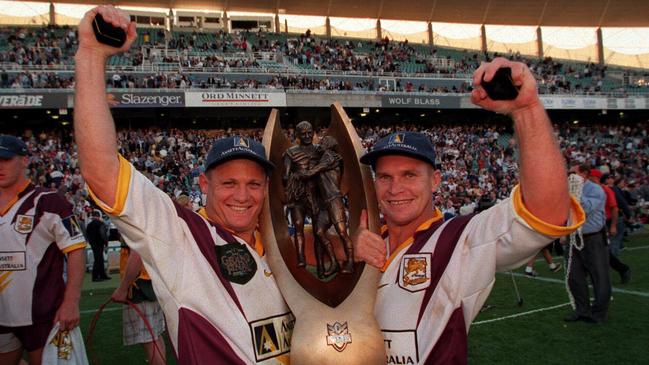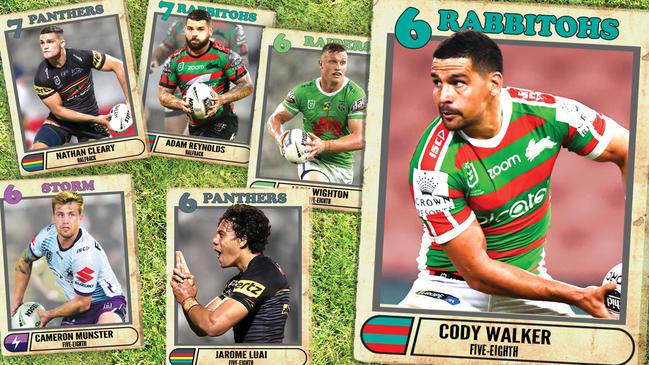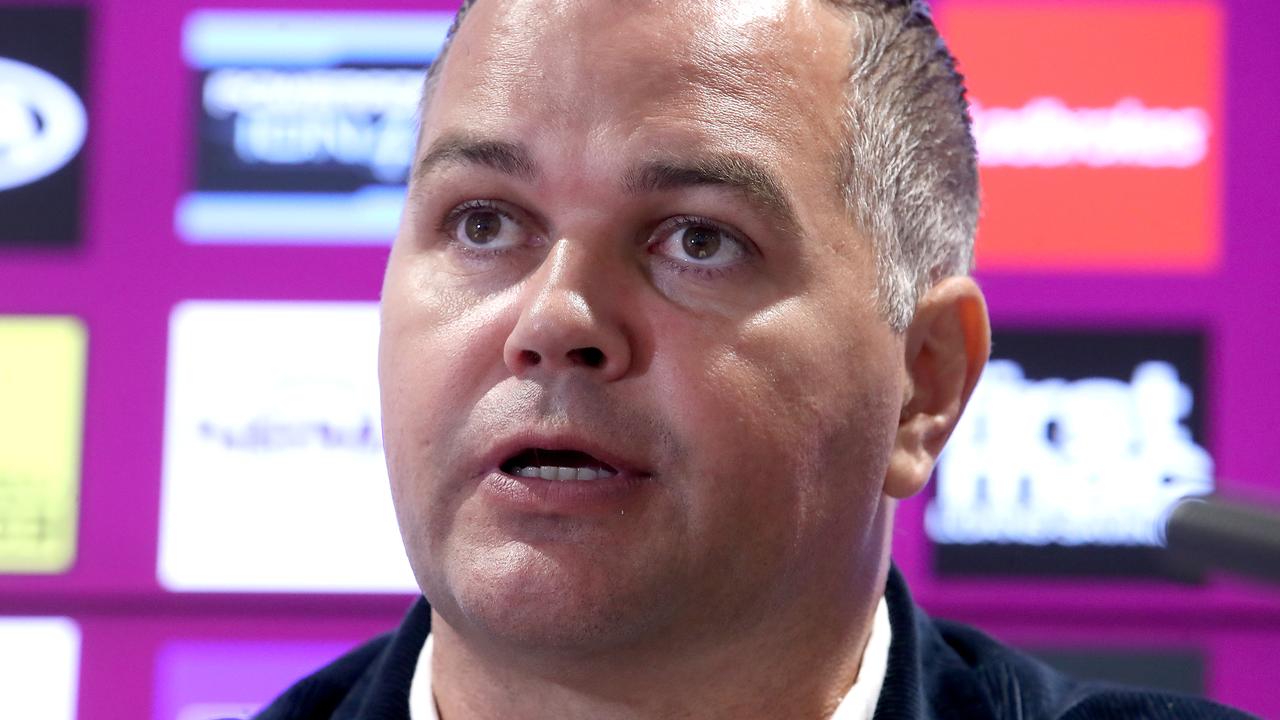Paul Kent: How the six-again rule has brought creativity back into the NRL
The fatigue factor in the NRL generated by the introduction of the six-again rule has brought creativity back into the game and the playmakers are thriving.

NRL
Don't miss out on the headlines from NRL. Followed categories will be added to My News.
It was only several years ago a strong lament went around the NRL, it never seems to be a weak lament, over the lack of natural playmakers in the game.
Playmaking was being coached out of the game, that was clear. The halfback and five-eighth positions had suddenly become interchangeable.
More often, one played on the left side and the other played on the right and the only time they came together was to check their stats after the game. Nothing more than a 50-50 split in possession was required.
And they played like robots, too. Stuck in structure, they played to pre-determined points on the field and passed into block shapes with no mind to what the defence was doing or the game’s tempo or what might be right for the game at that time.
Watch the 2020 NRL Telstra Premiership Finals on Kayo. Every game before the Grand Final Live & On-Demand with no-ad breaks during play. New to Kayo? Get your 14-day free trial & start streaming instantly >

Heaven forbid a defender failed his assignment and failed to mark up, the half wouldn’t know what to do.
Coaches didn’t really need to know how to coach anymore, either. They could just copy the gameplan every other team was using and then preach endlessly about the need for completions, knowing an 80 per cent completion rate was usually enough to win the game.
The game then doubled down its problem because, sitting over the coaches, the game was being run by bureaucrats, too many of whom couldn’t find the pointy end of the football but they had power and position and they gave the coaches the game they wanted and dismissed any criticism.
Then someone woke up one day and realised the quality playmakers were disappearing.
Fresh players, little fatigue, and junior coaches who strove to win premierships rather than educate their players had the junior halves playing the big man’s game.
The days of the great halves pairings, like Langer and Walters, Stuart and Daley, were a memory, and once a few grizzled souls recognised this they began campaigning the game to find ways to bring the playmaker back into the game.
As often happens in a bureaucracy, bad new rules were introduced to wallpaper over bad old rules.

Junior halves were put in vests and given special privileges. Passing limits were introduced. Other artificial means were written into the laws in an attempt to encourage halves to read the defence and play their instinct rather than pre-ordained structured game plans.
And then came along ARL Commission chairman Peter V’landys who realised the answer, as it usually is, was not more rules, but less.
The shift came earlier this season when V’landys bulldozed the over-governance within the game and instead of waiting for the Competition Committee to get together at season’s end, where several days of heavy pontificating usually followed, V’landys simply told everyone the new six-again rule was being introduced.
There, deal with it.
V’landys ignored the complaints it needed to be pressure-tested and instead listened to the complaints of the silent majority who agreed the game was too structured and wrestling was strangling it to death. And so he fixed it with the stroke of a pen.
The impact was almost immediate, and on Saturday night four of the most exciting halves in the game go around after another four of the most exciting halves went around on Friday night.

Nathan Cleary and Adam Reynolds play primarily as first receivers for their teams while outside them Jarome Luai and Cody Walker play more traditional five-eighth roles.
A similar situation was there Friday in the eliminator between Melbourne and Canberra.
It’s enough to make you wonder what this weekend’s preliminary finals might have looked like if the rule change had not been implemented.
Certainly it found out a few coaches, and reinvented an old one.
Mostly, it has taken the game away from the athletes and given it back to the players.
Rabbitohs hooker Damien Cook says the trust and understanding in the Rabbitohs spine has found a new level this season.
“We’re running the game together,” he says. “Instead of us being individuals, it’s all one. Especially the last few months.
“We know that if one of us does something the other two are ready to follow.”
Coach Wayne Bennett has put enough coaching in for them to understand what he wants from them on the paddock but, importantly, he has left enough space in his instructions for them to fill the rest themselves.
The new rules have allowed it.

And players like Walker have flourished.
The knock on Walker carried one of those strong biases that are hard to get around.
It went that he was not a big-game player, which immediately creates a problem because the only way Walker can refute it is by playing in big games, which come along rarely, and so Walker is left to carry the burden.
There was never anything wrong with Walker.
If there was a problem it was that the old rules, and the rigid structure they promoted, made it more difficult for him because he was always such an instinctive player.
Similarly, there might not have been a position for Luai if the old rules were still in place.
Like Walker, Luai has pitch perfect instinct. And like Walker has with Reynolds, he has a ying and yang partnership with Cleary.
Like all the great halves pairings had.
MORE NRL NEWS
Richo: ‘There wasn’t any blue about Cody’
Dally M’s add touch of Hollywood to big night
Once this season is finally over the NRL will gather the Competition Committee again and it should make for an awkward few days.
For years they resisted moves to introduce fatigue, which is the key to the success of V’landys’ six-again rule, adopting the argument of coaches who knew no other way to coach.
Coaches hate the rules to encourage fatigue because tired players make mistakes, and the one thing coaches can’t coach against is fatigue.
The only thing the Competition Committee should be considering is where the next phase of fatigue begins and what it looks like, such as further reduction in the interchange.
Fatigue should no longer be a dirty word.
As this weekend’s halves pairings have shown, fatigue can be a good thing.
***
Hello darkness my old friend …
In trying to end the scourge of online trolling former Brisbane Broncos coach Anthony Seibold has simply added to it.
Such is one danger of social media; you become what you most dislike.
Seibold’s campaign to find the culprits behind the vile slur campaign peaked last week when 60 Minutes, over the Simon and Garfunkel soundtrack, dedicated more than half its show to the dangers of trolling and where Seibold, after repeatedly refusing to identify who it was beyond a person of “prominence”, then tossed the whole NSW Rugby League into the pot by saying the culprit worked there.
Of course, first thing it did was going to ratchet up the chatter on social media while around the game plenty of conversations as to who it might be were held.

By not naming the person, Seibold put everyone under suspicion.
It’s hard to think it could get worse, but it did.
The person was later identified as a minor Country Rugby League refereeing official, a name unrecognisable outside his own family.
What’s worse, it is believed the official didn’t do anything more than what most people did: when he received the text he simply passed it on to a few friends as idle gossip.
The author of the texts has yet to be discovered.
Seibold’s dossier is so light it is in danger of floating away.
Originally published as Paul Kent: How the six-again rule has brought creativity back into the NRL




